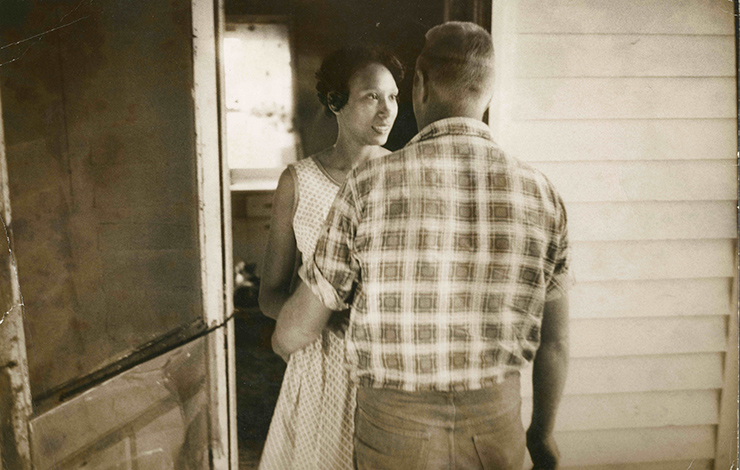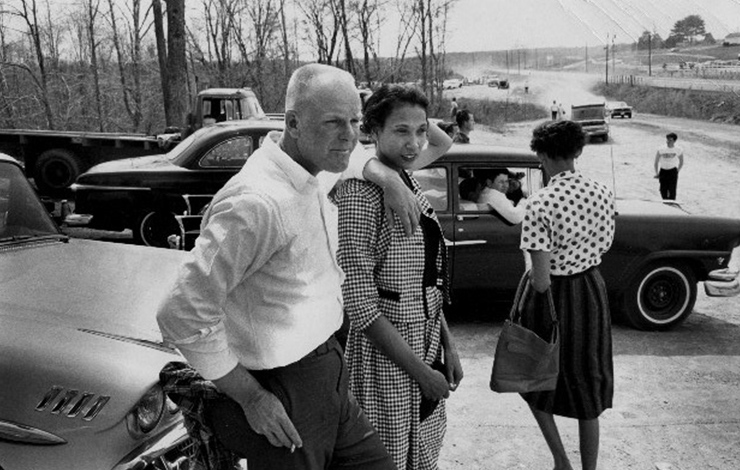
After watching Mildred Jeter Loving's quiet, collected manner of speaking, one gets the sense that this is a woman who never intended to be in the spotlight. Palpable too is her husband Richard's shyness and hesitancy to engage with anyone but his family. So it makes sense that first-time director Nancy Buirski didn't become fully aware of the couple's story--one integral to the evolution of the Civil Rights struggle yet surprisingly hidden in the wings of history's stage--until after Mildred's passing in 2008. After becoming aware of their compelling story, Buirski embarked on a quest to reconstruct the past for her first feature, The Loving Story.
Mildred and Richard Loving were an interracial couple living in Caroline County, Virginia at a time when miscegenation was considered a felony in more than 25 states, carrying a prison sentence ranging from one to five years. Hoping to circumvent the Racial Integrity Act that prevented their union in their home state, the two were legally married in the District of Columbia in June 1958. Just over a month had passed before the couple was arrested in the middle of the night as they lay in bed in their small house. Richard, a white man, spent one night in jail; Mildred, a woman of African and Rappahannock descent, was locked up for five days. This single incident ignited a dramatic change not only in the private life of the Lovings, but also in the direction of the Civil Rights movement.
The Lovings' story is conveyed through radiant black-and-white footage courtesy of filmmaker Hope Ryden and cinematographer Abbot Mills; Ryden had persuaded her employer, Drew Associates, to let her and Mills film the couple in 1965. In addition, The Loving Story includes selections from a photo essay by Life magazine photographer Grey Villet, and present-day interviews with those who were close to the family. Buirski connected with Bernie Cohen and Phil Hirschkop, two attorneys from the American Civil Liberties Union (ACLU) who took the Lovings' case all the way to the Supreme Court; Mildred and Richard's daughter Peggy; law enforcement officials from Caroline County; and family friends. Through these varied perspectives, Buirski accomplishes great and understated feats of empathy and inspiration.
"I was immediately drawn into their world when I saw that footage, and I realized that's what we could do for our viewers," Buirski affirms. And after founding the Full Frame Documentary Film Festival in 1998 and running it for ten years, she knew what she wanted from Ryden and Mills' black-and-white recordings. "I stepped down from my role as director of the festival because I wanted to make films," Buirski explains. "When I first came across this project, I thought I would produce it. But the closer I got to the project, I just said, ‘I have to do this.'" With her burning desire to once again involve herself in artistic pursuits (she is an experienced photographer and painter, and was foreign picture editor at The New York Times), Buirski set off to find, piece by piece, the details that made up the history of this family.
We find these details in the untouched moments from their home life: Mildred sitting in her sparsely decorated living room in unadorned attire, Richard comfortable enough with Villet's camera to lay his head on his wife's lap. While focus at times shifts from the Lovings to the lawyers and their experiences with the case, The Loving Story does little to betray the nature of its main subjects. Throughout, it remains as understated and collected as the strong married couple whose narrative carries the film. There's no flashy editing, no invasive or emotionally manipulative music, no voice-of-God narration.
Buirski's intent from the onset was to make this story seem as though it happened yesterday. "You go in and out of the period that way because you've got many contemporary voices, in addition to your period events," Buirski explains. "The decision to allow the footage to breathe, to create long scenes with the footage, was really about allowing us to be with and live with the Lovings. You don't have that opportunity very often in historical documentaries."
The cinéma vérité style employed by Ryden and Mills ensures that feeling of immediacy and intimacy so important to Buirski's vision, placing the viewer within the domestic space of this family, as Mildred tells the story of their struggle, the Loving children play outside, and Richard grips Mildred's hand as they await the Supreme Court's decision. For such a landmark legislation, there are surprisingly no major cuts to footage of Civil Rights marches. Instead, we see the couple celebrate these massive victories they helped facilitate in their composed embraces and stolen looks. Richard isn't much for verbosity or public displays of affection. To truly understand why the Lovings fought their sentence as strongly as they did, one needs only to listen to Richard: "Tell the Court I love my wife," he says. "And it's just unfair that I can't live with her in Virginia."

What certainly cannot go unmentioned is the strong sense of currency the viewer feels from the moment we are introduced to the injustices the Lovings face before their ruling is officially overturned. Not recognized as a legally married couple in their home state of Virginia, Richard, Mildred and their children are forced to live in secrecy. We see a conversation with the lawyers shift from hope to reality; in the event the Lovings are arrested again before the official hearing, Cohen and Hirschkop make sure the couple has their contact information.
Same-sex couples who cannot marry under current laws have cried during screenings of The Loving Story, empathizing with this couple over their similar struggle for marriage equality. To think that all anti-miscegenation laws were finally overturned as recently as 40 years ago truly brings home the reality that our latest civil rights struggle might only be just beginning. The fight for true marriage equality might have a long way to go, but this story reminds us that even two people in love can make a huge difference.
Above all, the film harbors a lingering sense of personal agency. If the Lovings teach us nothing else, it's that anyone can change the course of history. Sometimes, the subdued patience of a humble couple speaks just as loudly as public forums and demonstrations.
When Mildred is asked why they took their case to the ACLU, she says, "We could go away, but it's the principle. It's the law; I don't think it's right. And if we do win, we'll be helping a lot of people." They might not have intended to cause such a metamorphosis in the course of America's history, but the Lovings prove that even the soft-spoken can be heard clearly.
The Loving Story airs February 14 on HBO.
Katharine Relth is the Web Producer at the International Documentary Association. She has previously written about film for TribecaFilm.com.
